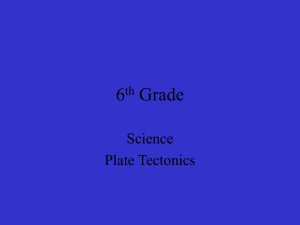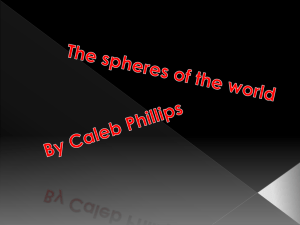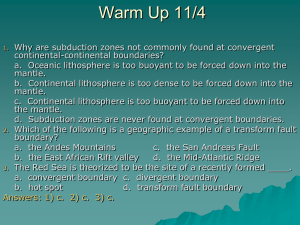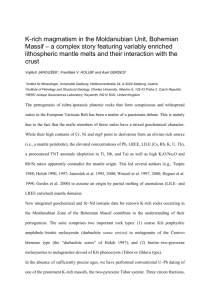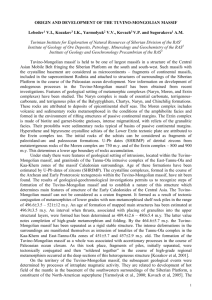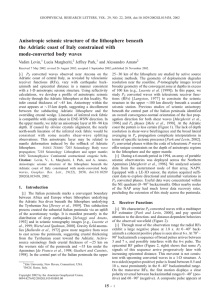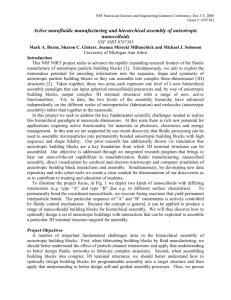Seismic anisotropy of the upper mantle beneath the
advertisement
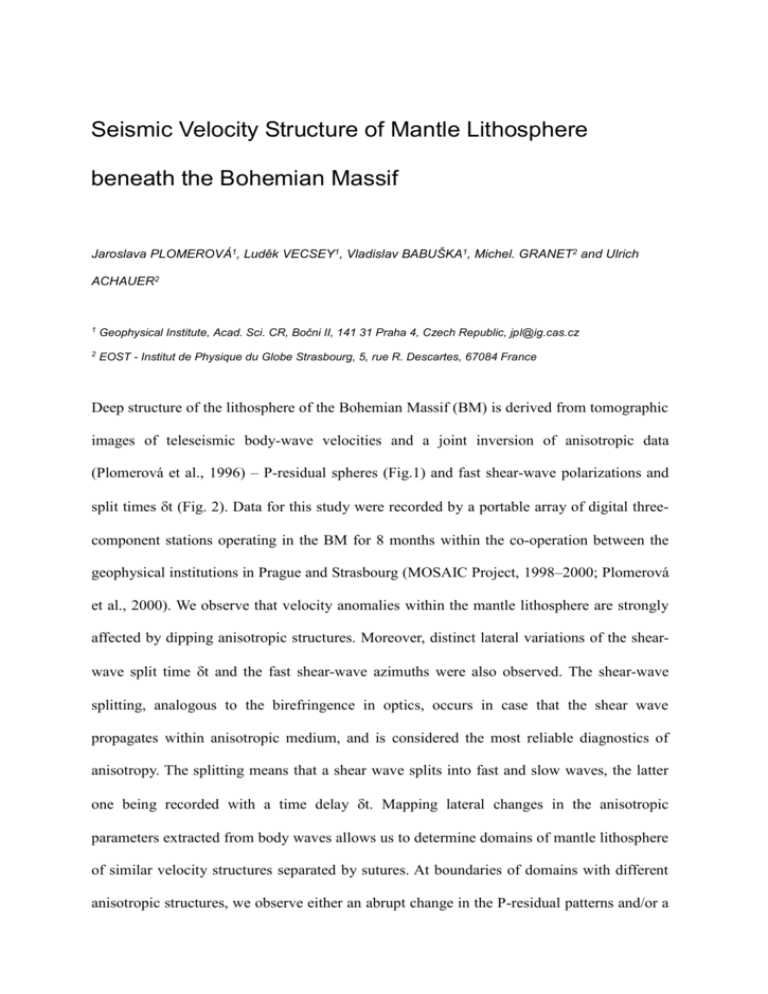
Seismic Velocity Structure of Mantle Lithosphere beneath the Bohemian Massif Jaroslava PLOMEROVÁ1, Luděk VECSEY1, Vladislav BABUŠKA1, Michel. GRANET2 and Ulrich ACHAUER2 1 Geophysical Institute, Acad. Sci. CR, Bočni II, 141 31 Praha 4, Czech Republic, jpl@ig.cas.cz 2 EOST - Institut de Physique du Globe Strasbourg, 5, rue R. Descartes, 67084 France Deep structure of the lithosphere of the Bohemian Massif (BM) is derived from tomographic images of teleseismic body-wave velocities and a joint inversion of anisotropic data (Plomerová et al., 1996) – P-residual spheres (Fig.1) and fast shear-wave polarizations and split times t (Fig. 2). Data for this study were recorded by a portable array of digital threecomponent stations operating in the BM for 8 months within the co-operation between the geophysical institutions in Prague and Strasbourg (MOSAIC Project, 1998–2000; Plomerová et al., 2000). We observe that velocity anomalies within the mantle lithosphere are strongly affected by dipping anisotropic structures. Moreover, distinct lateral variations of the shearwave split time t and the fast shear-wave azimuths were also observed. The shear-wave splitting, analogous to the birefringence in optics, occurs in case that the shear wave propagates within anisotropic medium, and is considered the most reliable diagnostics of anisotropy. The splitting means that a shear wave splits into fast and slow waves, the latter one being recorded with a time delay t. Mapping lateral changes in the anisotropic parameters extracted from body waves allows us to determine domains of mantle lithosphere of similar velocity structures separated by sutures. At boundaries of domains with different anisotropic structures, we observe either an abrupt change in the P-residual patterns and/or a significant decrease in split time of sub-vertically propagating shear-waves sampling both units. Steep and narrow sutures sharply delimit domain boundaries, while inclined contacts, such as the Saxothuringian (ST) and Moldanubian (MD) contact in the westernmost BM, result in a broader transitional region above the suture (Babuška and Plomerová, 2001). According to anisotropic parameters of body waves, we can distinguish several domains in the mantle lithosphere of the BM. While a large t and a general E–W orientation of the fast split wave prevail in the western and central parts of the BM, the t in the eastern part is smaller and the fast polarization rotates to the WNW–ESE direction (Fig. 2). The null split solutions or a decrease in the split times are related to the ST/MD contact in the western part of the BM and in the eastern Moldanubian around longitude 15.5E (see the BM1 station in Fig. 2). The latter lateral change is associated with the effects caused by wave propagation within the complex mantle lithosphere formed by the Brunovistulian domain (e.g., Gnojek and Hubatka, 2002) underthrust beneath the eastern MD. The P residual spheres indicate that there is no substantial difference between the velocity structure of the mantle lithosphere beneath the MD and the Teplá-Barrandian Unit (TBU). But the spheres indicate that the velocity structure of the northern part of the BM differs from that of the MD. We interpret the observed variations of the anisotropic parameters by olivine models with generally orientated (dipping) symmetry axes. While the (a,c) foliations dip mostly to the NW in the ST and Sudetes, they dip to the S in the MD. As shown by lateral changes in the anisotropic parameters, the mantle lithosphere of the BM, similarly to other Variscan massifs such as the Armorican Massif (Judenherc et al., 2002) or the French Massif Central (Babuška et al., 2002), consists of at least three domains with different orientation of large-scale olivine fabric separated by sutures cutting the whole lithosphere. Acknowledgements The research was partly supported by grant projects 205/01/1154 of the Grant Agency of the Czech Republic, A3012908 of the Grant Agency of the AS CR and 128/630/01 of the Ministry of the Environment of the Czech Republic. References BABUŠKA V. and PLOMEROVÁ J., 2001. Subcrustal lithosphere around the Saxothuringian-Moldanubian Suture Zone - a model derived from anisotropy of seismic wave velocities. Tectonophysics, 332: 185-199. BABUŠKA V., PLOMEROVÁ J., VECSEY L., GRANET, M. and ACHAUER U., 2002. Seismic anisotropy of the French Massif Central and predisposition of Cenozoic rifting and volcanism by Variscan suture hidden in the mantle lithosphere. Tectonics, 21: U407-U429. GNOJEK I. and HUBATKA F., 2001. Structure of the Brunovistulian Unit (E part of the Czech Republic) on the basis of seismic and magnetic data. Bull. Czech Geol. Survey, 76: 157-168. JUDENHERC S., GRANET M., BRUN J-P., POUPINET G., PLOMEROVÁ J., MOSQUET A. and ACHAUER U., 2002. Images of lithospheric heterogeneities in the Armorican segment of the Hercynian range in France. Tectonophysics, 358: 121-134. PLOMEROVÁ J., ŠÍLENÝ J. and BABUŠKA V., 1996. Joint interpretation of upper mantle anisotropy based on teleseismic P-travel time delays and inversion of shear-wave splitting parameters. Phys. Earth. Planet. Int., 95: 293-309. PLOMEROVÁ J., GRANET M., JUDENHERC S., ACHAUER U., BABUŠKA V., JEDLIČKA P., KOUBA D. and VECSEY L, 2000. Temporary array data for studying seismic anisotropy of Variscan Massifs - the Armorican Massif, French Massif Central and Bohemian Massif. Stud. Geophys. Geodet., 44: 195-209. th o x Sa n a i ng i r u Sud etes Moldanubian Br un ov ist ul ia n ? Fig. 1. P residual spheres showing directional terms of the relative P residuals constructed from 35 teleseismic events recorded during the MOSAIC experiment. Black diamonds show negative residuals (high-velocity directions), light grey diamonds represent positive residuals (low-velocity directions) and dots denote residuals close to zero. The outer circle of the spheres corresponds to an angle of propagation 60 below the M-discontinuity. Size of the signs is related to magnitude of the residuals. Fig. 2. Fast shear-wave polarization azimuths and split times t of the SKS and SKKS phases. Arrows point in dip azimuths of the fast S polarisation vectors evaluated in 3D. Length of the arrows is proportional to the t.



